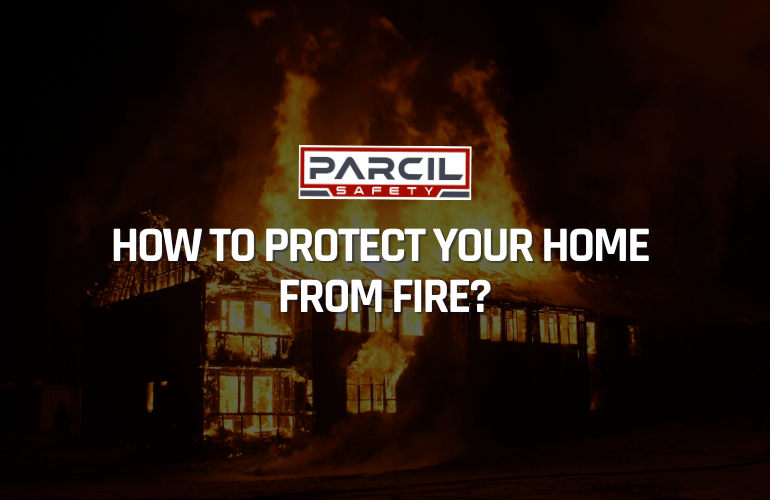A house fire can start in seconds and spread before you realize it.
According to the National Fire Protection Association (NFPA), U.S. fire departments respond to over 350,000 home fires each year, resulting in billions of dollars in property damage and thousands of injuries.
Most of these fires start from small, preventable sources.
Fire protection is about being ready long before the smoke appears. With a plan, the right tools, and reliable gear, you can drastically improve your family’s chances of staying safe.
Explore Parcil Safety Fire Gear Here
🔌 Step 1: Identify and Eliminate Fire Hazards

Fire prevention begins with awareness.
Common causes of home fires include overloaded outlets, faulty wiring, unattended cooking, and space heaters left too close to flammable materials.
Here’s what to check:
- Unplug appliances that are not in use
- Replace damaged cords and avoid daisy-chaining power strips
- Keep space heaters at least 3 feet away from anything that can burn
- Never leave cooking unattended
- Test smoke alarms monthly and replace batteries twice a year
The U.S. Fire Administration (USFA) recommends installing smoke alarms on every level of your home and inside each bedroom. These early warnings can cut your risk of dying in a home fire by half.
🧯 Step 2: Keep Fire Blankets in Key Areas
![]()
Fire extinguishers are important, but fire blankets are faster, cleaner, and easier to use when seconds matter.
They smother flames instantly by cutting off oxygen and are especially useful for grease or electrical fires that should not be sprayed with water.
Keep Parcil Safety Fire Blankets in areas where fire is most likely to start:
- The kitchen (for grease fires)
- The garage or workshop (for fuel or electrical fires)
- Near fireplaces and space heaters
To use one, pull the tabs, cover the flames completely, and leave it in place until the surface cools.
You can also wrap a fire blanket around someone if their clothing catches fire.
According to Ready.gov, having easy-to-access fire safety tools increases survival rates in household fire incidents significantly.
Explore Parcil Safety Fire Blankets Here
🔥 Step 3: Create and Practice a Fire Escape Plan

An escape plan can mean the difference between panic and control.
Every room should have at least two exit routes, with one being a window if possible.
Do this:
- Identify two exits for every room
- Keep windows and hallways clear
- Mark exits with glow-in-the-dark tape or LED lighting
- Choose a safe outdoor meeting point
- Practice your escape plan twice a year with everyone in the household
Families that practice their escape plan have been shown by the NFPA to evacuate twice as fast during a real emergency.
😷 Step 4: Protect Your Lungs From Smoke and Fumes

Most fire-related deaths come from smoke inhalation, not burns.
Toxic gases and particles can quickly overwhelm anyone trying to evacuate, especially in enclosed spaces.
Keep a respirator ready in your emergency kit to protect your lungs while escaping.
The Parcil Safety ST-100X Gas Mask Respirator offers:
- A full-face seal for complete protection
- A wide, fog-resistant visor for visibility
- Compatibility with 40mm NATO filters
- Reliable performance in low-visibility conditions
Store one near your main exits or in your emergency go bag.
Even 30 seconds of clean air can make a crucial difference when moving through smoke.
🧰 Step 5: Build a Fire Emergency Kit

Preparation means having the right gear ready to go.
A fire safety kit should always include:
- Fire blankets
- A full-face respirator (like the ST-100X)
- A flashlight and spare batteries
- A first aid kit
- Bottled water
- A backup phone charger
- Emergency contact list
Keep your kit in an easy-to-grab location near your primary exit.
Everyone in the home should know where it is and how to use each item.
💨 Step 6: Review and Maintain Your Safety Gear
Fire readiness requires upkeep.
Set a reminder to inspect your gear every six months. Replace filters, check your fire blankets, and test your smoke alarms.
The NFPA also recommends replacing fire extinguishers every 10 years and blankets if they show signs of wear.
A quick review can prevent small issues from becoming life-threatening.
House fires move fast, but preparation keeps you one step ahead.
The right equipment gives you time, clarity, and confidence.
Keep fire blankets within reach in every high-risk area.
Equip respirators like the ST-100X for safe evacuation and breathable air when conditions turn dangerous.
Train your family, check your gear, and stay ready.
When it comes to home safety, the strongest tool you can have is preparation.




















Leave a comment
All comments are moderated before being published.
This site is protected by hCaptcha and the hCaptcha Privacy Policy and Terms of Service apply.